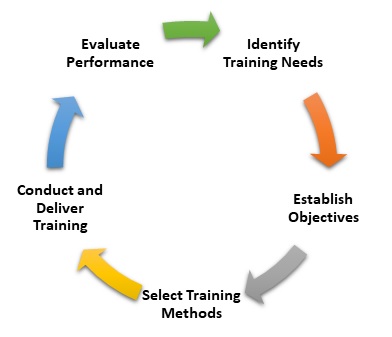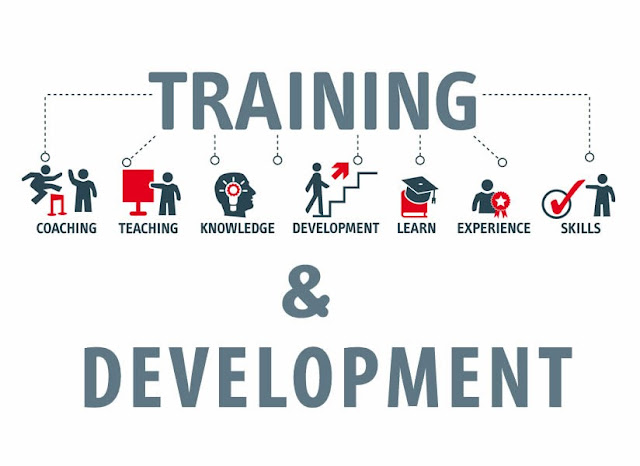Leveraging Training and Development to Enhance Organizational Performance
WHAT IS TRAINING & DEVELOPMENT
Training and development is the ongoing process of enhancing abilities, learning new information, refining ideas, and altering mindset via organized, planned instruction with the goal of raising employee performance and productivity. Training and development place a strong emphasis on enhancing both individual and group performance inside the company by implementing an appropriate system that focuses on the knowledge, abilities, and material needed to accomplish the goal. Effective employee training fosters the growth of their abilities and knowledge, which in turn boosts a business's production and fosters overall expansion. mba skool (2016).
Training and Development Process
Training and development is a continuous process as the skills, knowledge and quality of work needs constant improvement. Since businesses are changing rapidly, it is critical that companies focus on training their employees after constantly monitoring them & developing their overall personality Ana Paula Ferreira (2016).
Steps for training and development processes
1. Determine the need of training and development for individuals or teams
First of all the need has to be seen for training and development. it has to align with the company's goals and objectives.
2. Establish specific objectives & goals which need to be achieved
The goals and objectives of the training and development have to be established. Whether the goal is awareness about new products or even installation is required to be learnt.
3. Select the methods of training
Next, methods have to be defined. The training can be done as a :
1. Classroom Training
2. Online Self paced courses
3. Course with certification
4. Instructor led online training
4. Conduct and implement the programs for employees
After the plan and methods are finalized, the training and development programs have to be executed where courses, instructions are taught to the employees, partners or vendors.
5. Evaluate the output and performance post the training and development sessions
Training and Development is incomplete without proper monitoring. Monitoring can be done through evaluation of the instructor as well as attendees. Instructor evaluation can be done through feedback or ratings but attendees can be evaluated through internal or external certifications or scores.
6. Keep monitoring and evaluating the performances and again see if more training is required
Based on the evaluation results in the previous step, management needs to ascertain that if the training and development program was sufficient for now or more training and enablement would be required. Also, if future trainings are to be planned.
 |
| figure 1 Training & Development Circle |
The Importance of Training and Development
In today's dynamic and competitive business environment, the significance of training and development cannot be overstated. It serves as a cornerstone for organizational success, driving employee performance, engagement, and overall business growth. Let's delve deeper into why training and development are crucial for any organization: kelly walter (2017).
1. Skill Enhancement and Knowledge Acquisition:
Training and development initiatives provide employees with opportunities to acquire new skills, expand their knowledge base, and stay abreast of industry trends. Whether it's technical skills related to their job function or soft skills such as communication, leadership, and problem-solving, continuous learning empowers employees to perform their roles more effectively.
2. Improved Performance and Productivity:
Investing in training and development directly correlates with improved employee performance and productivity. When employees receive the necessary training to excel in their roles, they become more competent, confident, and efficient in carrying out their responsibilities. This, in turn, leads to higher quality output, increased efficiency, and ultimately, enhanced organizational performance.
3. Enhanced Employee Engagement and Retention:
Training and development initiatives demonstrate an organization's commitment to the growth and development of its employees. This fosters a positive work environment where employees feel valued, supported, and motivated to contribute their best efforts. Engaged employees are more likely to stay with the company, reducing turnover rates and associated recruitment costs.
4. Adaptation to Change and Innovation:
In today's rapidly evolving business landscape, organizations must be agile and adaptable to stay competitive. Training and development play a crucial role in equipping employees with the skills and knowledge needed to navigate change effectively. Moreover, fostering a culture of innovation through continuous learning enables organizations to identify new opportunities, solve problems creatively, and stay ahead of market trends.
5. Strategic Alignment and Organizational Growth:
Training and development initiatives should be aligned with the organization's strategic goals and objectives. By investing in the development of skills and competencies that are directly tied to business priorities, organizations can drive sustainable growth and achieve long-term success. Training becomes not just an expense, but an investment in the organization's future success.
6. Compliance and Risk Mitigation:
In regulated industries, training is essential for ensuring compliance with laws, regulations, and industry standards. By providing employees with the necessary training on compliance-related topics, organizations can mitigate risks, avoid legal issues, and uphold ethical standards. This not only protects the organization from potential liabilities but also fosters a culture of accountability and integrity.
Advantages of training and development
Training and development has a cost attached to it. However, since it is beneficial for companies in the long run, they ensure employees are trained regularly. Some advantages are:
1. Helps employees develop new skills and increases their knowledge.
2. Improves efficiency and productivity of the individuals as well as the teams.
3. Proper training and development can remove bottle-necks in operations.
4. New & improved job positions can be created to make the organization leaner.
5. Keeps employees motivated and refreshes their goals, ambitions and contribution levels.
Disadvantages of training and development
Even though there are several advantages, some drawbacks of training and development are mentioned below:
1. It is an expensive process which includes arranging the correct trainers and engaging employees for non-revenue activities.
2. There is a risk that after the training and development session, the employee can quit the job.
CONCLUTION
A training and development program's efficacy should be assessed according to its capacity to satisfy learning objectives, enhance performance, support organizational objectives, and yield a profitable return on investment. To guarantee that training initiatives stay relevant and effective in meeting the changing needs of individuals and the business, ongoing assessment and improvement are crucial. Hence, training & development programme are very important to achieving organizational goals.
Reference
Ana Paula Ferreira,(2016),training & development in organization,reserchgate ,pg 105-119 (online)
https://www.researchgate.net/profile/Ana-Paula-Ferreira
mba skool,(2014),.Training and Development - Definition, Importance, mbaskool(online)
https://www.mbaskool.com/business-concepts/human-resources-hr-terms/8685-training-and-development.html
kelly walter,(2017),The Importance of Training and Development in Employee Performance and Evaluation. ,research gate ,
pg 206-212 (online)
Available at:
https://www.researchgate.net/publication/332537797_The_Importance_of_Training_and_Development_in_Employee_Performance_and_Evaluation



I think organisations should have a clear stratergie of employee trainig and development to enhance the maximum productivity out of each and employee of and organisation in a sustainable manner.Nice articale.
ReplyDeleteVery good topic selection and organization of contents
ReplyDeleteTraining and development programs aim to enhance employees' skills, knowledge, and performance through various methods like workshops, online courses, mentoring, and on-the-job training.
ReplyDeleteLeveraging training and development boosts organizational performance by upskilling employees and aligning competencies with strategic goals. Investing in continuous learning fosters innovation, employee engagement, and adaptability, driving sustained success in dynamic business landscapes.
ReplyDelete
ReplyDeleteThis post effectively explores the concept of training and development and its crucial role in enhancing organizational performance.